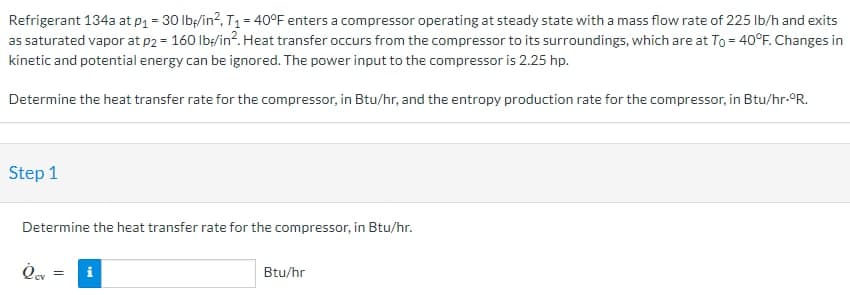Refrigerant 134a at p₁ = 30 lb/in², T₁ = 40°F enters a compressor operating at steady state with a mass flow rate of 225 lb/h and exits as saturated vapor at p2 = 160 lb/in². Heat transfer occurs from the compressor to its surroundings, which are at To = 40°F. Changes in kinetic and potential energy can be ignored. The power input to the compressor is 2.25 hp. Determine the heat transfer rate for the compressor, in Btu/hr, and the entropy production rate for the compressor, in Btu/hr-ºR. Step 1 Determine the heat transfer rate for the compressor, in Btu/hr. Qov i Btu/hr
Refrigerant 134a at p₁ = 30 lb/in², T₁ = 40°F enters a compressor operating at steady state with a mass flow rate of 225 lb/h and exits as saturated vapor at p2 = 160 lb/in². Heat transfer occurs from the compressor to its surroundings, which are at To = 40°F. Changes in kinetic and potential energy can be ignored. The power input to the compressor is 2.25 hp. Determine the heat transfer rate for the compressor, in Btu/hr, and the entropy production rate for the compressor, in Btu/hr-ºR. Step 1 Determine the heat transfer rate for the compressor, in Btu/hr. Qov i Btu/hr
Elements Of Electromagnetics
7th Edition
ISBN:9780190698614
Author:Sadiku, Matthew N. O.
Publisher:Sadiku, Matthew N. O.
ChapterMA: Math Assessment
Section: Chapter Questions
Problem 1.1MA
Related questions
Question
100%
pls answer the given thanks

Transcribed Image Text:Refrigerant 134a at p₁ = 30 lb/in², T₁ = 40°F enters a compressor operating at steady state with a mass flow rate of 225 lb/h and exits
as saturated vapor at p2 = 160 lb/in². Heat transfer occurs from the compressor to its surroundings, which are at To = 40°F. Changes in
kinetic and potential energy can be ignored. The power input to the compressor is 2.25 hp.
Determine the heat transfer rate for the compressor, in Btu/hr, and the entropy production rate for the compressor, in Btu/hr-°R.
Step 1
Determine the heat transfer rate for the compressor, in Btu/hr.
Qo
=
i
Btu/hr
Expert Solution
This question has been solved!
Explore an expertly crafted, step-by-step solution for a thorough understanding of key concepts.
Step by step
Solved in 2 steps

Knowledge Booster
Learn more about
Need a deep-dive on the concept behind this application? Look no further. Learn more about this topic, mechanical-engineering and related others by exploring similar questions and additional content below.Recommended textbooks for you

Elements Of Electromagnetics
Mechanical Engineering
ISBN:
9780190698614
Author:
Sadiku, Matthew N. O.
Publisher:
Oxford University Press

Mechanics of Materials (10th Edition)
Mechanical Engineering
ISBN:
9780134319650
Author:
Russell C. Hibbeler
Publisher:
PEARSON

Thermodynamics: An Engineering Approach
Mechanical Engineering
ISBN:
9781259822674
Author:
Yunus A. Cengel Dr., Michael A. Boles
Publisher:
McGraw-Hill Education

Elements Of Electromagnetics
Mechanical Engineering
ISBN:
9780190698614
Author:
Sadiku, Matthew N. O.
Publisher:
Oxford University Press

Mechanics of Materials (10th Edition)
Mechanical Engineering
ISBN:
9780134319650
Author:
Russell C. Hibbeler
Publisher:
PEARSON

Thermodynamics: An Engineering Approach
Mechanical Engineering
ISBN:
9781259822674
Author:
Yunus A. Cengel Dr., Michael A. Boles
Publisher:
McGraw-Hill Education

Control Systems Engineering
Mechanical Engineering
ISBN:
9781118170519
Author:
Norman S. Nise
Publisher:
WILEY

Mechanics of Materials (MindTap Course List)
Mechanical Engineering
ISBN:
9781337093347
Author:
Barry J. Goodno, James M. Gere
Publisher:
Cengage Learning

Engineering Mechanics: Statics
Mechanical Engineering
ISBN:
9781118807330
Author:
James L. Meriam, L. G. Kraige, J. N. Bolton
Publisher:
WILEY